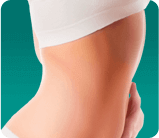Fat vs Filler
 While most of my Dayton cosmetic surgery patients are familiar with dermal fillers such as Restylane®, Juvéderm® and Allo Derm®, not all of them are familiar with an alternative to dermal fillers—autologous fat.
While most of my Dayton cosmetic surgery patients are familiar with dermal fillers such as Restylane®, Juvéderm® and Allo Derm®, not all of them are familiar with an alternative to dermal fillers—autologous fat.
What is Autologous Fat?
Autologous fat comes from oneself. It’s not donated by another person, like donated corneas. It’s your fat. The procedure to obtain and use autologous fat is called fat transfer or fat grafting and, essentially, involves removing fat from one part of the body through liposuction and processing the fat before injecting it into an area in which plumping is desired, such as the back of the hands, in the lips, breasts or buttocks, or in facial wrinkles. Autologous fat injection has great potential as a replacement for dermal fillers like those listed above because fat injections are permanent. Once the fat “takes,” it won’t disappear. Although the fat that “takes” will stay around forever, the correction, of course, isn’t permanent because we continue to age, even with fillers or facelifts. Nevertheless, my Dayton facelift patients are delighted to shave 10-15 years from their appearance to they can at least “reset” the time clock!
Fat Grafting Benefits
One of the most obvious benefits of fat grafting/fat transfer is that you cannot have an adverse reaction to your own fat cells. Secondly, autologous fat is soft and natural, and unlikely to “clump” or solidify in a way that appears unnatural, as can (rarely) happen with the injection of dermal fillers. Since it’s more “permanent” than dermal fillers, fat can surpass the 6-month improvement with Restylane® or the 9-12-month correction period of Juvéderm®. Dayton patients who desire soft, natural correction that can “outlast” the more traditional FDA-approved fillers, find that fat is an excellent material.
How I Perform Fat Grafting in Dayton
As mentioned above, fat grafting involves liposuction, i.e., removing the fat from one place so it can be injected somewhere else. Once the nerve block is in place, the fat is removed via liposuction, it’s spun down and the fat cells are grafted (injected) into the desired area(s). The procedure itself is quite straight-forward, with minimal discomfort and a fast recovery rate.
The Bottom Line About Fat Grafting Vs Fillers
Fat grafting can create a permanent correction in the area that receives the fat, and most of my Dayton wrinkle filler patients chose fat over fillers because the results are quite reliable and it’s less expensive than fillers. Therefore, fat transfer is a viable alternative and, as technology improves, may ultimately replace fillers. Until that happens, just know that here in Dayton you have an option!
To your health and beauty,
Raymond Wolf, DO
Dayton Cosmetic Surgeon









